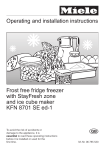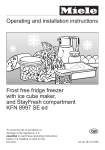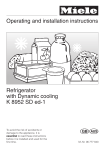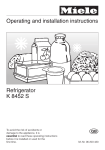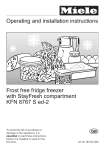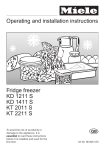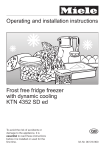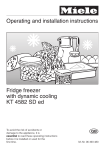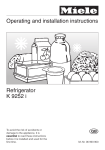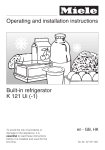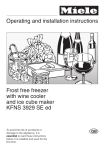Download Miele K 8767 S ed Operating instructions
Transcript
Operating and installation instructions Refrigerator with StayFresh compartment K 8767 S ed K 8767 S ed-1 To avoid the risk of accidents or damage to the appliance, it is essential to read these operating instructions before it is installed or used for the first time. G M.-Nr. 06 213 251 Contents Description of the appliance . . . . . . . . . . . . . . . . . . . . . . . . . . . . . . . . . . . . . . . . . 4 Caring for the environment . . . . . . . . . . . . . . . . . . . . . . . . . . . . . . . . . . . . . . . . . . 6 Warning and Safety instructions . . . . . . . . . . . . . . . . . . . . . . . . . . . . . . . . . . . . . 7 How to save energy . . . . . . . . . . . . . . . . . . . . . . . . . . . . . . . . . . . . . . . . . . . . . . . 11 Switching on and off . . . . . . . . . . . . . . . . . . . . . . . . . . . . . . . . . . . . . . . . . . . . . . 12 Safety lock . . . . . . . . . . . . . . . . . . . . . . . . . . . . . . . . . . . . . . . . . . . . . . . . . . . . . . . 12 Switching off for longer periods of time . . . . . . . . . . . . . . . . . . . . . . . . . . . . . . . . . 13 The correct temperature . . . . . . . . . . . . . . . . . . . . . . . . . . . . . . . . . . . . . . . . . . . 14 . . . in the refrigerator section and in the StayFresh zone . . . . . . . . . . . . . . . . . . . 14 Setting the temperature in the refrigerator section . . . . . . . . . . . . . . . . . . . . . . . . 14 Temperature range . . . . . . . . . . . . . . . . . . . . . . . . . . . . . . . . . . . . . . . . . . . . . . 15 Setting the temperature in the StayFresh zone . . . . . . . . . . . . . . . . . . . . . . . . . . . 15 Temperature display . . . . . . . . . . . . . . . . . . . . . . . . . . . . . . . . . . . . . . . . . . . . . . . 16 Temperature display brightness . . . . . . . . . . . . . . . . . . . . . . . . . . . . . . . . . . . . 16 Alarm . . . . . . . . . . . . . . . . . . . . . . . . . . . . . . . . . . . . . . . . . . . . . . . . . . . . . . . . . . . 17 Switching the alarm off early . . . . . . . . . . . . . . . . . . . . . . . . . . . . . . . . . . . . . . . . . 17 Switching on the alarm system . . . . . . . . . . . . . . . . . . . . . . . . . . . . . . . . . . . . . . . 17 Super cool . . . . . . . . . . . . . . . . . . . . . . . . . . . . . . . . . . . . . . . . . . . . . . . . . . . . . . 18 Using the refrigerator efficiently. . . . . . . . . . . . . . . . . . . . . . . . . . . . . . . . . . . . . 19 Different storage zones . . . . . . . . . . . . . . . . . . . . . . . . . . . . . . . . . . . . . . . . . . . . . 19 Warmest area . . . . . . . . . . . . . . . . . . . . . . . . . . . . . . . . . . . . . . . . . . . . . . . . . . 19 Coldest area . . . . . . . . . . . . . . . . . . . . . . . . . . . . . . . . . . . . . . . . . . . . . . . . . . . 19 StayFresh zone . . . . . . . . . . . . . . . . . . . . . . . . . . . . . . . . . . . . . . . . . . . . . . . . . . . 19 Low humidity level , . . . . . . . . . . . . . . . . . . . . . . . . . . . . . . . . . . . . . . . . . . . . . 20 High humidity level - . . . . . . . . . . . . . . . . . . . . . . . . . . . . . . . . . . . . . . . . . . . 20 Food which should not be stored in a refrigerator. . . . . . . . . . . . . . . . . . . . . . . . . 20 Storing food correctly. . . . . . . . . . . . . . . . . . . . . . . . . . . . . . . . . . . . . . . . . . . . . . . 21 Fruit and vegetables . . . . . . . . . . . . . . . . . . . . . . . . . . . . . . . . . . . . . . . . . . . . . 21 Different types of unpacked meats and vegetables must be kept separate.. . 21 Protein rich foods . . . . . . . . . . . . . . . . . . . . . . . . . . . . . . . . . . . . . . . . . . . . . . . 21 Meat . . . . . . . . . . . . . . . . . . . . . . . . . . . . . . . . . . . . . . . . . . . . . . . . . . . . . . . . . 21 Adjusting the interior fittings . . . . . . . . . . . . . . . . . . . . . . . . . . . . . . . . . . . . . . . 22 Automatic defrost . . . . . . . . . . . . . . . . . . . . . . . . . . . . . . . . . . . . . . . . . . . . . . . . 23 Refrigerator section and StayFresh zone. . . . . . . . . . . . . . . . . . . . . . . . . . . . . . . . 23 Contents Cleaning and care . . . . . . . . . . . . . . . . . . . . . . . . . . . . . . . . . . . . . . . . . . . . . . . . 24 Cleaning the outer casing, the interior and accessories . . . . . . . . . . . . . . . . . . . . 24 Ventilation gaps . . . . . . . . . . . . . . . . . . . . . . . . . . . . . . . . . . . . . . . . . . . . . . . . . . . 25 Door seal . . . . . . . . . . . . . . . . . . . . . . . . . . . . . . . . . . . . . . . . . . . . . . . . . . . . . . . . 25 Problem solving guide. . . . . . . . . . . . . . . . . . . . . . . . . . . . . . . . . . . . . . . . . . . . . 26 Noises . . . . . . . . . . . . . . . . . . . . . . . . . . . . . . . . . . . . . . . . . . . . . . . . . . . . . . . . . 28 After sales service . . . . . . . . . . . . . . . . . . . . . . . . . . . . . . . . . . . . . . . . . . . . . . . . 29 Electrical connection . . . . . . . . . . . . . . . . . . . . . . . . . . . . . . . . . . . . . . . . . . . . . . 30 Electrical connection U.K. . . . . . . . . . . . . . . . . . . . . . . . . . . . . . . . . . . . . . . . . . . . 30 Installation . . . . . . . . . . . . . . . . . . . . . . . . . . . . . . . . . . . . . . . . . . . . . . . . . . . . . . 31 Location . . . . . . . . . . . . . . . . . . . . . . . . . . . . . . . . . . . . . . . . . . . . . . . . . . . . . . . . . 31 Climate range . . . . . . . . . . . . . . . . . . . . . . . . . . . . . . . . . . . . . . . . . . . . . . . . . . 31 Ventilation. . . . . . . . . . . . . . . . . . . . . . . . . . . . . . . . . . . . . . . . . . . . . . . . . . . . . . . . 31 Installation . . . . . . . . . . . . . . . . . . . . . . . . . . . . . . . . . . . . . . . . . . . . . . . . . . . . . . . 31 Aligning the appliance . . . . . . . . . . . . . . . . . . . . . . . . . . . . . . . . . . . . . . . . . . . . . . 32 Changing the door hinging . . . . . . . . . . . . . . . . . . . . . . . . . . . . . . . . . . . . . . . . . 33 StayFresh zone compartments . . . . . . . . . . . . . . . . . . . . . . . . . . . . . . . . . . . . . . . 36 Description of the appliance a Safety lock indicator light b On/Off button c Temperature display d Controls for setting the temperature left hand button: warmer right hand button: colder e Super cool button and indicator light f Alarm off button 4 Description of the appliance g Butter and cheese compartment h Egg tray i Interior lighting j Shelves k Fruit and vegetable containers l Door shelf m StayFresh zone, dry compartment n Condensate channel and drain hole o Control for setting the moisture level in the humidity controlled compartment p StayFresh zone, humidity controlled compartment 5 Caring for the environment Disposal of the packing material The transport and protective packing has been selected from materials which are environmentally friendly for disposal, and can normally be recycled. Ensure that any plastic wrappings, bags etc. are disposed of safely and kept out of the reach of babies and young children. Danger of suffocation! Rather than just throwing these materials away, please ensure that they are recycled. Disposal of your old appliance Please ensure that the appliance presents no danger to children while being stored for disposal. It should be unplugged or disconnected from the mains electricity supply by a competent person. The plug must be rendered useless and the cable cut off directly behind the appliance to prevent misuse. See the "Warning and Safety" section of this booklet for further details. Electrical and electronic appliances often contain materials which, if handled or disposed of incorrectly, could be potentially hazardous to human health and to the environment. They are, however, essential for the correct functioning of your appliance. Please dispose of your old appliance at your local community waste collection / recycling centre and not with your household waste. Take care not to damage the pipework at the back of it before or during transportation to an authorised collection depot. In this way, refrigerant in the pipework and oil in the compressor will be contained, and will not leak out into the environment. 6 Warning and Safety instructions Technical safety This appliance complies with all relevant legal safety requirements. Improper use can, however, present a risk of both personal injury and material damage. To avoid the risk of accidents and damage to the appliance, read the operating instructions carefully before installation and before using for the first time. They contain important notes on the installation, safety, operation and care of the appliance. Keep these operating instructions in a safe place and pass them on to any future user. Correct use This appliance is intended for domestic use only for the cool storage of food and drink. Any other usage is not supported by the manufacturer and could be dangerous. The manufacturer cannot be held liable for damage caused by incorrect or improper use of the appliance. This appliance is not a toy! To avoid the risk of injury, do not allow children to play on or near it, or to play with the controls. Supervise its use by the elderly or infirm. This appliance contains the coolant Isobutane (R600a), a natural gas which is environmentally friendly. Although it is flammable, it does not damage the ozone layer and does not increase the greenhouse effect. The use of this coolant has, however, led to a slight increase in the noise level of the appliance. In addition to the noise of the compressor, you might be able to hear the coolant flowing around the system. This is unavoidable, but does not have any adverse effect on the performance of the appliance. Care must be taken during transportation and setting up of the appliance that no parts of the cooling system are damaged. Leaking coolant can damage the eyes. In the event of any damage: - avoid open fires and anything which creates a spark, - disconnect from the mains, - air the room in which the appliance is located for several minutes and - contact the Service Department for advice. The more coolant there is in an appliance, the larger the room it should be installed in. In the event of a leakage, if the appliance is in a small room, there is the danger of combustible gases building up. For every 8 g of coolant at least 1 m3 of room space is required. The amount of coolant in the appliance is stated on the data plate inside the appliance. 7 Warning and Safety instructions Before connecting the appliance to the mains supply make sure that the rating on the data plate corresponds to the voltage and frequency of the household supply. This data must correspond in order to avoid the risk of damage to the appliance. Consult a qualified electrician if in any doubt. The electrical safety of this appliance can only be guaranteed when continuity is complete between the appliance and an effective earthing system which complies with local and national safety regulations. It is most important that this basic safety requirement is present and regularly tested, and where there is any doubt, the household wiring system should be inspected by a qualified electrician. The manufacturer cannot be held liable for the consequences of an inadequate earthing system (e.g. electric shock). Safe operation of the appliance is only assured if it has been installed and connected in accordance with these operating and installation instructions. This equipment may only be used in mobile installations such as ships, caravans, aircraft etc. if a risk assessment of the installation has been carried out by a suitably qualified engineer. Installation work, maintenance and repairs may only be carried out by suitably qualified and competent persons in accordance with national and local safety regulations. Repairs and other work by unqualified persons could be dangerous and the 8 manufacturer will not be held liable. Ensure current is not supplied to the appliance until after maintenance or repair work has been carried out. The appliance is only completely isolated from the electricity supply when: – it has been switched off at the wall socket and the plug has been withdrawn. – the mains fuse is withdrawn, or – the screw-out fuse is removed (in countries where this is applicable). Do not connect the appliance to the mains electricity supply by an extension lead. Extension leads do not guarantee the required safety of the appliance (e.g. danger of overheating). Use Do not store explosive materials in the appliance or any products containing propellants (e.g. spray cans). Thermostats switching on may produce sparks which could present a fire hazard. Flammable compounds could explode. Do not use any electrical equipment in this appliance, e.g. ice cream makers. Danger of sparking and explosion! If storing alcohol with a high percentage proof, make sure it is tightly closed and stored upright. Danger of explosion. Warning and Safety instructions Observe the "use by" dates given on food to avoid the risk of food poisoning. Storage times will depend on several factors, including the freshness and quality of the food as well as the temperature at which it is stored. Follow the instructions given on food manufacturer's packaging on storage conditions required, as well as the "use by" date. Do not use sharp edged objects to – remove frost and ice, – separate food which has become frozen. They will damage the evaporator, causing irreversible damage to the appliance. Do not use defrosting sprays or de-icers, as they might contain substances which could damage the plastic parts or which could cause a build-up of gases and pose a danger to health. The appliance is designed for use within certain climate ranges (ambient temperatures), and should not be used outside this range. The climate range for your appliance is stated on the data plate inside the appliance. Installing it in a room with too low an ambient temperature, e.g. a garage, will lead to the appliance switching off for longer periods so that it cannot maintain the required temperature. Do not use a steam-cleaning appliance to clean this appliance. Pressurised steam could reach the electrical components and cause a short circuit. In countries where there are areas which may be subject to infestation by cockroaches or other vermin, pay particular attention to keeping the appliance and its surroundings in a clean condition at all times. Any damage which may be caused by cockroaches or other vermin will not be covered by the guarantee. Do not use any oils or grease on the door seals, as these will cause the seals to deteriorate and become porous with time. Do not store cooking oil in the refrigerator door. Traces of oil can cause stress cracks to occur in the plastic components in the door. Do not block the ventilation gaps in the appliance as this would impair the efficiency of the appliance, increase the electricity consumption and could cause damage to the appliance. 9 Warning and Safety instructions Disposal of your old appliance Before disposing of an old appliance, first make the door latch or lock unusable. This way you will prevent children from accidentally locking themselves in and endangering their lives. Disconnect the appliance. Cut off the cable and render any plug unusable. Be careful not to damage any part of the pipework whilst awaiting disposal, e.g. by – puncturing the refrigerant channels in the evaporator. – bending any pipework. – scratching the surface coating. Splashes of refrigerant can damage the eyes. The manufacturer cannot be held liable for damage caused by non-compliance with these Warning and Safety instructions. 10 How to save energy Installation normal energy consumption increased energy consumption In a ventilated room. In an enclosed, unventilated room. Protected from direct sunlight. In direct sunlight. Not situated near to a heat source (radiator, oven). Situated near to a heat source (radiator, oven). Where the ambient room temperature is ideal at approx. 20 °C. Where there is a high ambient room temperature. Temperature setting with With a medium setting of 2 to 3. a thermostat which is approximate (set in stages). With a high setting: The lower the compartment temperature, the higher the energy consumption. Temperature setting with Cellar section 8 to 12 °C a thermostat which is Refrigerator section 4 to 5 °C exact to the degree (digital display). StayFresh zone approx. 0 °C Freezer section -18 °C On appliances with winter setting, please make sure that the winter setting is switched off when the ambient temperature is warmer than 16 °C. Only open the door when necessary and for as short a time as possible. Frequent opening of the door for long periods will cause a loss of coldness. Store food in an organised way. If food is not stored in an organised way, searching for an item will mean the door is open for longer. Allow hot food and drinks to cool down before placing them in the appliance. Placing hot food in the appliance will cause the compressor to run for a long time, as the appliance will have to work harder to lower the temperature. Store food covered or packaged. The evaporation or condensation of liquids will cause a loss of coldness in the refrigerator. Use Place frozen food in the refrigerator to defrost. Do not over-fill the sections to allow air to circulate. Defrosting Defrost the freezer section when a layer of ice one centimetre thick has built up. A layer of ice hinders the cold from reaching the frozen food, and causes an increase in energy consumption. 11 Switching on and off Before using for the first time The stainless steel surface has a layer of protective foil to prevent scratching during transportation. ^ Do not remove this foil until the appliance has been installed or built in. Start at one of the upper corners. ^ Clean the inside of the appliance and the accessories with warm water and a little washing up liquid, and then dry with a soft cloth. Important: To ensure the correct functioning of the appliance, let it stand for between ½ and 1 hour after transporting it to its final location before connecting it to the mains. Switching on The cooling system is switched off. (If this does not happen, the safety lock is still activated). Safety lock The safety lock can be activated to prevent the appliance being switched off inadvertently. Activating or de-activating the safety lock ^ Press and hold the Super cool button for approx. 5 seconds. The Super cool indicator light flashes and a ; flashes in the temperature display. ^ Press the Super cool button again. ^ Press the On/Off button. The temperature display lights up, the appliance starts cooling. The interior light will come on when the door is opened. ; lights up in the temperature display. ^ You can now choose between ; 0 and ; 1 by pressing the temperature selector buttons: 0: the safety lock is de-activated, 1: the safety lock is activated. ^ Press the Super cool button to save the setting. Allow the appliance to run for a few hours before placing food in it. This will ensure that the temperature is sufficiently low. The safety lock indicator light X will light up when the safety lock has been activated. Switching off ^ Press the On/Off button to come out of the setting mode. ^ Press the On/Off button until the temperature display goes out. 12 The electronics will then switch over to normal operation after a couple of minutes. Switching on and off Switching off for longer periods of time If the appliance is not going to be used for a longer period of time, e.g. whilst on holiday, ^ switch the appliance off, ^ switch off at the wall socket and withdraw the plug, ^ clean the appliance out and ^ leave the door ajar to air the appliance. If, during a long absence, the appliance is switched off but not cleaned out and the door is left shut there is a danger of mould and odours building up inside the appliance. 13 The correct temperature It is very important to set the correct temperature for storing food in the appliance. Micro-organisms will cause food which is not stored at the correct temperature to deteriorate rapidly. Temperature influences the growth rate of these micro-organisms. Reducing the temperature reduces their growth rate. Setting the temperature in the refrigerator section Use the two buttons underneath the temperature display to set the temperature for the refrigerator section. Press the The temperature in the appliance will rise: – the more often the door is opened and the longer it is kept open, – if too much food is stored in it at once, – the warmer the food is which is being put into it, – the higher the ambient temperature surrounding the appliance. The appliance is designed for use in specific ambient temperatures (climate ranges). Do not use in ambient temperatures for which it is not designed. . . . in the refrigerator section and in the StayFresh zone We recommend a temperature of 4 °C in the refrigerator section. The temperature in the StayFresh zone is controlled automatically and is maintained at approx. 0 °C. 14 left hand button: to raise the temperature right hand button: to reduce the temperature The temperature being set will flash in the display. After setting the temperature you can see the following information in the display by pressing the buttons: – When first pressed, the last temperature selected flashes. – Each subsequent press of the button adjusts the temperature shown in 1 °C steps. – Keeping the button pressed in adjusts the temperature continually. Approx. 5 seconds after letting go of the button the display will change to show the current average temperature. The correct temperature If you have adjusted the temperature, wait for approx. 6 hours if the appliance is not very full and for approx. 24 hours if the appliance is full, before checking the temperature display as it will take this long for the display to show the accurate temperature of the appliance. If, after this time, the temperature is still too high or too low, you will need to adjust it again. Temperature range The temperature can be adjusted from: 4 °C to 9 °C ^ Press one of the temperature selector buttons repeatedly until a = appears in the display. Press the Super cool button again. = lights up in the display. ^ You can now adjust the temperature in the StayFresh zone by pressing the temperature selector buttons. You can choose from settings 1 to 9: 1: lowest temperature, 9: highest temperature. = 5 is the default setting for the StayFresh zone. If a setting of = 1 to = 4 is selected, the temperature can fall below 0°C. Food could freeze! The ambient temperature in the room and the installation location can affect the time it takes for the appliance to reach the lowest temperature. If the ambient temperature is too high, the appliance may not reach the lowest temperature. ^ Press the Super cool button to save the setting. Setting the temperature in the StayFresh zone The electronics will then switch over to normal operation after a couple of minutes. ^ Press the On/Off button to come out of the setting mode. The temperature in the StayFresh zone is automatically held at approx. 0 °C. It can be raised or lowered, e.g. if you want to use it for storing items like fish. ^ Press and hold the Super cool button for approx. 5 seconds. The Super cool indicator light flashes and a ; flashes in the temperature display. 15 The correct temperature Temperature display During normal operation, the temperature display on the control panel shows the average temperature in the refrigerator section. If the temperature is not within the range that the appliance is able to display (0 °C to 19 °C), bars will flash in the temperature display. The temperature display will flash, if – a different temperature is being set, – the temperature in the appliance has risen by several degrees, indicating that the appliance is warming up too much. This loss of coldness is no cause for concern if it is due to the door being left open for a while, e.g. for removing or storing a large amount of food. Temperature display brightness The appliance is supplied with the brightness of the temperature display set as low as possible. However, if the door is opened, a setting changed or if the alarm is sounding, the temperature display will appear much brighter for approx. 1 minute. You can adjust the level of brightness: ^ Press and hold the Super cool button pressed in for approx. 5 seconds. 16 The Super cool indicator light flashes and a ; flashes in the temperature display. ^ Press one of the temperature selector buttons repeatedly until an ^ appears in the display. ^ Press the Super cool button again. ^ lights up in the temperature display. ^ You can now adjust the level of brightness by pressing the temperature selector buttons. You can choose from settings 1 to 5: 1: lowest setting, 5: brightest setting. ^ Press the Super cool button to save the setting. ^ Press the On/Off button to come out of the setting mode. The electronics will then switch over to normal operation after a couple of minutes. Alarm Your appliance has been fitted with an alarm to avoid energy being wasted if the door is left open and to prevent stored food becoming too warm. The alarm will sound if the door is left open for more than approx. 60 seconds. The alarm will stop as soon as the door is closed. If you want to keep the door open for more than approx. 60 seconds, intentionally, we recommend that you switch the alarm off. Switching the alarm off early ^ Press the alarm button. The alarm will stop. Switching on the alarm system The alarm system switches back on automatically as soon as the door is closed. It does not have to be switched on manually. 17 Super cool Super cool Switching off Super cool The Super cool function can be used to rapidly reduce the temperature in the refrigerator section to its lowest setting (depending on the room temperature). The Super cool function switches itself off automatically after approx. 6 hours. The indicator light goes out and the appliance continues running at normal power. Switching on Super cool Super cool is particularly recommended for faster chilling of large amounts of fresh food or drink. ^ Press the Super cool button. The Super cool indicator light will come on. The appliance works at full power to lower the temperature in the appliance. 18 To save energy, the Super cool function can be switched off once food and drinks are sufficiently chilled. ^ Press the Super cool button. The Super cool indicator light will go out, and the appliance will continue to operate at normal power. Using the refrigerator efficiently Different storage zones Due to the natural circulation of the air in the appliance, there are different temperature zones in the refrigerator section. Cold, heavy air sinks to the lowest section of the appliance. Make use of the different zones when placing food in the appliance. Warmest area The warmest area is in the top section of the door. Use this for storing butter and cheese. Do not store explosive materials in the appliance or any products containing propellants (e.g. spray cans). Danger of explosion. If storing alcohol with a high percentage proof, make sure it is tightly closed, and store upright. Do not store cooking oil in the refrigerator door. Traces of oil can cause stress cracks to occur in the plastic components in the door. Coldest area The coldest area in a refrigerator is normally directly above the vegetable containers. In this appliance, however, the coldest area is in the StayFresh zone. Food must not touch the back wall of the appliance, as it may freeze to the back wall. StayFresh zone – dishes or baked goods containing eggs or cream, A temperature of between 0 - 3 °C combined with a high humidity level provides the optimum storage conditions for fresh food, enabling it to be kept fresher for longer than in a refrigerator. The freshness of food when first placed in the appliance is an important factor in determining how long it stays fresh. Bear this in mind when shopping. – fresh dough, cake mixtures, pizza or quiche dough, The temperature in the StayFresh zone is automatically held at approx. 0 °C. Use the coldest areas in the refrigerator section and in the StayFresh zone for all delicate and highly perishable food, e.g. – fish, meat, poultry, – sausage products, ready meals, – soft cheese and other dairy products, – pre-packed vegetables and other fresh food with a label stating it should be kept at a temperature of approx. 4 °C. 19 Using the refrigerator efficiently The StayFresh zone is divided into two areas: – The dry compartment has a relative humidity level of approx. 45 %. – The humidity controlled compartment has a control for setting the humidity level between 45 % and 90 %. Slide the control to the humidity level you require. The humidity level will also be affected by the moisture content of the food being stored and how often the compartment is opened. Low humidity level , ^ To set a humidity level of approx. 45 %, slide the control for the humidity controlled compartment over to the left ,. This humidity level is suitable for storing particularly delicate food such as fresh fish, shell fish, meat, poultry, sausage, dairy products and salads. High humidity level ^ To set a humidity level of approx. 90 %, slide the control for the humidity controlled compartment over to the right -. This humidity level is suitable for storing fresh produce such as vegetables, salad, herbs, and seasonal fruit. Store these types of food uncovered in the compartment. Food which should not be stored in a refrigerator Not all food is suitable for storing in the refrigerator. These include: – Fruit and vegetables which are sensitive to cold, such as bananas, avocado pears, papaya, passion fruit, aubergines, peppers, tomatoes and cucumbers – Fruit which is not yet ripe – Potatoes Keep food covered or packaged in this compartment with the exception of meat. 20 – Some hard cheeses, e.g. Parmesan Using the refrigerator efficiently Storing food correctly Store food covered or packaged. This will prevent food smells or tastes from affecting other foods, and prevent food from drying out and also any cross-contamination of bacteria. The growth of bacteria, such as salmonella, can be avoided by setting the correct temperature and maintaining good standards of hygiene. Fruit and vegetables Fruit and vegetables can be stored loose in the vegetable containers. However, you should bear in mind that some types of vegetables give off a natural gas which speeds up the rate at which food perishes. Some fruit and vegetables react strongly to this gas and should not be stored together. Examples of fruit which produce a large amount of this natural gas are: Apples, apricots, pears, nectarines, peaches, plums, avocado pears and figs. Examples of fruit and vegetables which react strongly to the natural gases given off by other types of fruit and vegetables are: Kiwis, broccoli, cauliflower, Brussels sprouts, mangos, honeydew melons, apples, apricots, cucumbers, tomatoes, pears, nectarines and peaches. Different types of unpacked meats and vegetables must be kept separate. To avoid any microbiological cross-contamination, these foods may only be stored together if they are wrapped. Protein rich foods Please note that foods rich in protein deteriorate faster than others. Shell fish for example deteriorates faster than fish, and fish deteriorates faster than meat. Meat Store meat in suitable containers, but uncovered in the low humidity compartment. (Undo wrappings and leave containers open). The surface of the meat will dry out slightly and protect it from bacterial growth thus increasing its storage qualities. To prevent the risk of bacterial contamination keep meat stored in suitable containers and do not let different types of meat come into direct contact with each other. Take food out of the StayFresh zone approx. 30 - 60 minutes before using it. The aroma and taste do not fully develop until the food has reached room temperature. 21 Adjusting the interior fittings Moving the shelves Adjusting the door shelves The shelves can be adjusted according to the height of the food. ^ Push the door shelf upwards, then remove it by pulling it forwards. ^ Pull the shelf forward as far as it will go; then lift it upwards to remove it. ^ Replace the door shelf at the required position. Ensure that it is securely pushed back into position. ^ With the rear barrier facing upwards, place the shelf at the required position. The rear barrier must face upwards to prevent food from touching the back of the appliance and freezing to it. Moving the bottle divider The bottle divider can be moved to the left or right to ensure that bottles are held securely in position when the door is opened and shut. Split shelf In order to accommodate tall items in the appliance, one of the shelves is divided. The front section can be pushed under the rear section. ^ Pull the front half of the glass shelf forwards slightly and then push it carefully under the rear half. StayFresh zone compartments ^ When loading and unloading items, pull the compartment right out by taking hold of it at the back and lifting it up to remove it. ^ To put it back in, pull the runners a right out and place the compartment on top of the runners. The front of the runners must be right up against the front of the compartment b. Push the compartment back in c. 22 Automatic defrost Refrigerator section and StayFresh zone Condensate and frost can build up on the back wall of the refrigerator section and the StayFresh zone whilst in use. These are automatically removed and defrosted by the appliance. The condensate is drained away via a channel and drain hole into an evaporation system at the back of the appliance. Ensure that the condensate channel and drain hole are kept clean and are never blocked so that condensate can flow away without hindrance. 23 Cleaning and care Never use cleaning agents containing abrasive substances such as sand, soda, acids or chemical solvents. "Non-abrasive" cleaning agents are also unsuitable as they can cause matt areas to appear. Stainless steel surfaces should be cleaned with a proprietary stainless steel cleaner following the manufacturer's instructions on the packaging. Make sure that no water can penetrate into the electronic unit or into the light. Do not let water get into the drainage channel and drain hole when cleaning. Do not use steam cleaning apparatus to clean the appliance. Steam could reach the electrical components and cause a short circuit. The data plate located inside the appliance must not be removed. It contains information which is required in the event of a service call. Before cleaning ^ Switch the appliance off, switch off at the socket and remove the plug. ^ Take any food out of the appliance and store it in a cool place. 24 ^ Take out any removable parts e.g. shelves for cleaning. ^ The stainless steel trim can be pulled off the front edge of the refrigerator section shelves for cleaning. Cleaning the outer casing, the interior and accessories ^ Clean the refrigerator section and the StayFresh zone at least once a month. ^ Accessories and shelves should all be hand-washed. The butter dish is, however, dishwasher safe. ^ Clean the condensate channel and drain hole frequently, so that condensate can drain away unhindered. Use a straw or similar to clear the drain if necessary. ^ Clean stainless steel surfaces with a suitable cleaning agent following the manufacturer's instructions on the packaging. ^ After cleaning, wipe the interior and accessories with a damp cloth and dry with a soft cloth. Leave the door open to air the appliance for a short while. E-Cloth ^ A microfibre "E-Cloth" is available from the Miele UK Spare Parts Department which is suitable for cleaning surfaces such as stainless steel, glass, plastic and chrome without the use of chemicals. Cleaning and care Ventilation gaps ^ The ventilation gaps should be cleaned on a regular basis with a brush or vacuum cleaner. A build up of dust will increase the energy consumption of the appliance. Door seal Do not use any oils or grease on the door seal as these will cause the seal to deteriorate and become porous over time. The door seal should be cleaned regularly with clean water and then wiped dry with a soft cloth. Metal grille at the back of the appliance The metal grille at the back of the appliance (heat exchanger) should be dusted at least once a year. A build-up of dust will increase the energy consumption of the appliance. When cleaning the grille, make sure that the pipework and other components do not get broken or damaged in any way. After cleaning ^ Replace all shelves and accessories in the refrigerator section and the StayFresh zone and put your food back into the appliance. ^ Close the appliance door, insert the plug in the socket and switch the appliance back on. 25 Problem solving guide Repairs to electrical appliances should only be carried out by a suitably qualified and competent person in accordance with local and national safety regulations. Repairs and other work by unqualified persons could be dangerous. The manufacturer cannot be held liable for unauthorised work. Some minor problems can be corrected without contacting the Service Department. What to do if . . . . . . the appliance does not get cool. ^ Check whether the appliance has been switched on. The temperature display must be lit up. ^ Check that the plug is correctly inserted in the socket and switched on. ^ Check that the fuse is not defective and that the mains fuse has not blown. If it has, contact the Miele Service Department. . . . the temperature in the refrigerator is too low. ^ Check whether, the metal grille (heat exchanger) at the back of the appliance has become too dusty. ^ The door has been opened too frequently, or a large amount of food has been put in at once. ^ Check that the door has been closed properly. . . . The temperature display is flashing. The temperature has risen by several degrees in the refrigerator section because ^ large quantities of food which are warm have been placed in the appliance. ^ the door was left open for too long whilst putting food into the appliance or rearranging it. When you finish putting food into the appliance or rearranging it the electronics automatically adjust the temperature to the one last set. A loss of coldness for a short period will not affect the food in the appliance. . . . the following messages show in the temperature display "F0" to "F5". ^ Select a warmer temperature. There is a fault. Call the Service Department. . . . the appliance is switching in too frequently and for too long. . . the alarm sounds. ^ Check whether the ventilation gaps have been covered over or become too dusty. 26 Has the appliance door been open for longer than 60 seconds? ^ Close the door. Problem solving guide . . . the floor of the refrigerator section or the StayFresh zone is wet? The drain hole is blocked. ^ Clean the condensate channel and drain hole. . . . the interior light in the refrigerator section is not working. ^ Was the door left open for too long? The lighting switches itself off automatically after approx. 15 minutes. If this is not the case, then the lamp is defective: ^ Disconnect the appliance from the mains. Switch off at the wall and withdraw the plug from the socket, or disconnect the mains fuse or remove the screw-out fuse in countries where this is applicable. ^ Screw the new lamp into the connection. Ensure it goes in correctly and make sure that seal c makes a tight fit. ^ Replace the cover by clipping it in at the rear and then pressing it in at the sides. If you still cannot remedy the fault having followed these suggestions, please contact the Miele Service Department. To prevent unnecessary loss of temperature it is advisable not to open the door while waiting for the appliance to be serviced. ^ Press the sides of the lamp cover together a, disengage the cover and unclip it at the rear b. ^ Unscrew the lamp and replace it with a new one. Lamp specification: 220 - 240 V, max. 25 W, E 14 fitting. 27 Noises Normal noises What causes them Brrrrr... Humming noise made by the motor (compressor). This noise can get louder for brief periods when the motor is switching on. Blubb, blubb.... A gurgling noise can be heard when coolant is circulating through the pipes. Click.... Clicking sounds are made when the thermostat switches the motor on and off. Sssrrrrr.... On multi-zone and frost free appliances you can sometimes just hear the movement of air circulating inside the appliance. Remember that the noise of the compressor and the coolant circulating in the system is unavoidable. Noises that you can easily rectify What causes them, and what can you do about them? Rattling, vibrating The appliance is uneven: Realign the appliance using a spirit level, by raising or lowering the screw feet underneath the appliance. The appliance is touching another appliance or piece of furniture: Move it away. Drawers, baskets or shelves are unstable or sticking: Check all removable items and refit them correctly. Are any bottles or containers unstable or knocking against each other? Separate them. The transport cable clips are hanging loose at the back of the appliance: Remove the clips. 28 After sales service In the event of a fault which you cannot correct yourself, or if the appliance is under guarantee, please contact: – your Miele Dealer or – the Miele Service Department (see back cover for address). When contacting your Dealer or the Service Department, please quote the model and serial number of your appliance. This information is given on the data plate inside the appliance. Please note that telephone calls may be monitored and recorded to improve our service. 29 Electrical connection Electrical connection U.K. Non-rewireable plugs (BS 1363) All electrical work should be carried out by a suitably qualified and competent person in accordance with local and national safety regulations. The fuse cover must be re-fitted when changing the fuse, and if the fuse cover is lost, the plug must not be used until a suitable replacement is obtained. The colour of the correct replacement cover is that of the coloured insert in the base of the plug, or the colour that is embossed in words in the base of the plug (as applicable to the design of the plug fitted). The appliance is supplied with a mains cable and moulded plug ready for connection to an a.c. single phase 220-240 V 50 Hz supply. The voltage and connected load are given on the data plate. Please ensure that these match the household mains supply. The fuse rating is quoted on the plug. Connection should be made via a suitable switched socket which is easily accessible. For extra safety it is advisable to install a residual current device (RCD) with a trip current of 30 mA (in accordance with DIN VDE 0664, VDE 0100, Section 739). Do not connect the appliance to the mains electricity supply by an extension lead. Extension leads do not guarantee the required safety of the appliance (e.g. danger of overheating). The appliance must not be connected to an inverter and must not be used with a plug adapter as these can cause damage to the appliance's electronic unit. 30 Replacement fuses should be ASTA approved to BS 1362 and have the correct rating. Replacement fuses and fuse covers may be purchased from your local electrical supplier. WARNING THIS APPLIANCE MUST BE EARTHED Installation Do not place any appliance which gives off heat, such as a toaster or microwave oven, on top of this appliance, as this would increase the appliance's energy consumption. Important: Appliances without side wall heating must not be installed "side-by-side" next to another refrigerator or freezer. This could cause condensation and subsequent damage between the two appliances. Climate range Ambient room temperature SN N ST T SN-ST SN-T +10 °C to +32 °C +16 °C to +32 °C +18 °C to +38 °C +18 °C to +43 °C +10 °C to +38 °C +10 °C to +43 °C Operating in a room which is too cold will cause the cooling system to switch off for too long causing the internal temperature in the appliance to rise with the risk of food deteriorating and going off. Ventilation Location The appliance should be installed in a dry, well-ventilated room. The room temperature should not go above or below the climate range for which the appliance is designed. The higher the ambient temperature of the room, the more energy the appliance requires to operate. It should not be installed where it is exposed to direct sunlight or directly adjacent to a heat-producing appliance such as an oven or a radiator. Climate range The appliance is designed for use within certain climate ranges (ambient temperatures), and should not be used outside this range. The climate range of this appliance is stated on the data plate inside the appliance. Air at the back of the appliance gets warm. To ensure sufficient ventilation, the ventilation gaps must not be covered over. The air inlet and outlet must not be covered or blocked in any way. They should be dusted on a regular basis. Installation ^ Remove any cable clips from the back of the appliance. ^ Check that all parts at the back of the appliance are unhindered. Remove any hindrance. ^ Carefully push the appliance into position. The appliance can be placed directly against a wall. 31 Installation Aligning the appliance ^ To align the appliance adjust the feet using the spanner supplied. 32 Changing the door hinging The appliance is supplied right hand hinged. If left hand door hinging is required, follow the instructions below. ^ Remove the cover caps from the opposite side, and fit them into the empty holes. Removing the door handle: Changing over the door: First the side section of the handle must be removed: ^ Open the appliance door. ^ Pull door handle a towards you. Side section b slides back, creating a gap d between side section b and mounting plate c. ^ Place a suitable object (e.g. a spoon handle) in gap d, and slowly lever the handle towards the door. Be careful not to let the "spoon handle" slip, causing damage to the appliance. ^ Use a screwdriver to lever plinth a out, then pull it forwards and out. ^ Use a screwdriver to remove cover b, then close the door. ^ Remove screw c completely. ^ Pull door support d together with hinge pin e downwards, then tilt it forwards and take it off. The side section b can now be removed. ^ Pull side section b out of the guides on the mounting plate. ^ Loosen the 4 screws (Torx 15) in the mounting plate, and remove the handle. 33 Changing the door hinging ^ Open the appliance door, tilt it downwards and take it off. Keep it in a safe place just in case you ever decide to change the door hinging back to right hand hinging. ^ Screw the tappet supplied n into the opposite side using the same screw o. ^ Hang the door on hinge pin h and then close the appliance door. In the following illustration the door is not shown in the closed position to make it easier to see what happens next. ^ Remove cover f, and unscrew hinge bracket g. ^ Fit hinge pin h in the second hole of hinge bracket g. ^ Refit bracket i and cover j turned through 180° on the opposite side. ^ Screw hinge bracket g into the opposite side. The M4 screw has to be screwed into the left hole of the hinge bracket. ^ Turn cover f through 180°, and fit it on the other side. ^ Remove spacer k with a screwdriver and refit it on the opposite side. ^ Remove plug l from the door bearing bush in the door and refit on the opposite side. ^ Unscrew tappet m. 34 ^ Turn door support b around, pull hinge pin a out, and refit on the opposite side. ^ Fit both parts into hinge plate f. To do this push hinge pin a through hinge plate f into door support b. Swing the door support in, push upwards and re-assemble with screw c. Changing the door hinging ^ Align the door with the appliance housing using the long slot in hinge plate f. Then tighten screw c. ^ Refit plinth fascia d, pushing it firmly into position. ^ With the door open, position cover e in the front of the plinth fascia, and push it firmly into position. Refitting the handle: Please make sure you follow the instructions below carefully when you refit the handle. The door seal will be damaged if the handle is fitted incorrectly. ^ Then tighten all 4 fixing screws b. ^ Slide the side section of the handle d into the guides on the mounting plate until it clicks into place. It is important to check that the side section of the handle d does not come into contact with the door seal when opening the door, as this would damage the door seal permanently. If, after you have refitted the handle, you find that the side section does touch the door seal when the door is opened: ^ Realign mounting plate c with grub screws a until the mounting plate and the side section of the handle d are at the correct angle and the side section does not touch the seal when the door is opened. ^ Loosely attach the handle to the opposite side of the door with the two front screws b. Mounting plate c must be positioned on the side of the door so that when the door is closed it is flush with the side of the appliance. If this is not the case, ^ Tighten both grub screws a with the allen key provided until mounting plate c lines up correctly. 35 Changing the door hinging StayFresh zone compartments ^ Pull the compartment right out by taking hold of it at the back and lifting it up to remove it. ^ Pull the compartment lid forwards a. ^ Push the compartment lid in towards the side that the appliance is going to be opened from once the hinges have been changed over b, and fit it back on the runners. ^ Push the lid in until it engages c. ^ To put the compartment back in, pull the runners a right out and place the compartment on top of the runners close up against the door opening side. The front of the runners must be right up against the front of the compartment b. The compartment will click into position. You can now push the compartment back in c. 36 Make sure that the compartment lid covers the compartment correctly. 37 38 39 Alteration rights reserved / 4804 K 8767 S ed, K 8767 S ed-1 M.-Nr. 06 213 251 / 00 en / GB








































